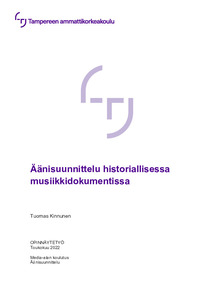| dc.contributor.author | Kinnunen, Tuomas | |
| dc.date.accessioned | 2022-05-05T08:28:30Z | |
| dc.date.available | 2022-05-05T08:28:30Z | |
| dc.date.issued | 2022 | - |
| dc.identifier.uri | http://www.theseus.fi/handle/10024/746811 | |
| dc.description.abstract | Opinnäytetyö tutkii äänisuunnittelua historiallisen musiikkidokumentin tyylilajissa. Tavoitteena oli havainnoida, löytyykö tyylilajin teoksista samankaltaisia, tyypillisiä tai eriäviä äänikerronnan muotoja, miten äänisuunnittelun eri elementtejä on käytetty, ja mistä nämä ratkaisut johtuvat. Lisäksi opinnäytetyössä pohditaan erityisesti äänisuunnittelijan taustaa, mikäli teoksessa on oma äänisuunnittelija, sekä musiikin roolia äänikerronnassa. Aihepiiri on rajattu tarkemmin 1900-luvun toisella puoliskolla syntyneitä musiikkiliikkeitä käsitteleviin teoksiin. Tyylilajia tutkitaan neljän case-esimerkin kautta, joita ovat Suomen rave-kulttuurin historia -dokumenttisarja ja dokumenttielokuvat Tee se itse -elämä: Combat Rockin tarina, We Call It Techno! ja Sisters with Transistors. Äänisuunnittelija Joonas Jyrälän ammattihaastattelu antoi myös yleisellä tasolla ja muutamien esimerkkien kautta lisää perspektiiviä aiheeseen.
Case-esimerkkien budjetit, julkaisualustat ja tyylit näyttivät jossain määrin vaikuttavan eri äänisuunnittelun elementtien määrälliseen käyttöön. Yhtenäisissä tekijöissä korostuivat etenkin musiikin monimuotoinen käyttö ja rooli äänikerronnassa, sekä eri vuosikymmeniltä ja eritasoisilla laitteilla taltioidun arkistoäänen vaihteleva laatu. Erityispiirteenä voisi pitää myös sitä, että monella äänen jälkitöistä vastaavista henkilöistä oli teoksien musiikkigenreihin liittyvää musiikillista taustaa.
Pelkästään näiden case-esimerkkien perusteella ei voida yksinkertaistaa mitä historiallisen musiikkidokumentin äänisuunnittelu on, tai mitä se ei ole. Esimerkkielokuvien äänisuunnittelun purkaminen kuitenkin auttanee dokumenttien äänisuunnittelijoita miettimään mitä se voisi olla erilaisissa puitteissa. Tämä prosessi on auttanut myös kirjoittajaa +358 BPM - Suomen hardcore techno -skenen tarina -dokumentin äänisuunnittelun aloittamisessa. | fi |
| dc.description.abstract | This thesis examines sound design in the genre of historical music documentary. The goal was to examine whether similar, typical or different forms of sound storytelling can be found, how different sound design elements have been used in the works of the genre, and why these solutions have been used. In addition, the thesis focuses on the background of the sound designer, on whether the work has its own sound designer, and the role of music in sound storytelling. The topic is narrowed down to documentaries dealing with music scenes that were born in the second half of the 20th century. The genre is discussed through four case studies, which are Suomen rave-kulttuurin historia (History of Finland’s rave culture) documentary series and the documentary films Tee se itse -elämä: Combat Rockin tarina (Do it yourself life: The story of Combat Rock), We Call It Techno! and Sisters with Transistors. A professional interview of sound designer Joonas Jyrälä also gave more perspective on the topic on a general level and through a few examples.
The budgets, release platforms, and styles of the case examples seemed to have had some effect on the variety of the different sound design elements that were used. The diverse use of music and its role in sound storytelling, as well as the varying quality of the archival sound recorded in different decades and with equipment of varying quality, were particularly emphasized in the common features. It could also be considered characteristic of the genre that many of the people in charge of the sound post-production had musical backgrounds related to the music genres of the documentaries.
These case studies alone cannot narrow down what the sound design of a historical music documentary is or is not. However, analyzing the sound design through case studies can probably help documentary sound designers to think what it could be under various circumstances. The research has also helped the author in starting his own sound design process of the documentary +358 - Suomen hardcore techno -skenen tarina (+358 BPM - The story of Finland’s hardcore techno scene). | en |
| dc.language.iso | fin | - |
| dc.rights | CC BY-SA 4.0 | - |
| dc.title | Äänisuunnittelu historiallisessa musiikkidokumentissa | - |
| dc.type.ontasot | fi=AMK-opinnäytetyö|sv=YH-examensarbete|en=Bachelor's thesis| | - |
| dc.identifier.urn | URN:NBN:fi:amk-202205057313 | - |
| dc.subject.specialization | Äänisuunnittelu | - |
| dc.subject.degreeprogram | fi=Media-ala|sv=Mediebranschen|en=Media| | - |
| dc.subject.yso | äänisuunnittelu | - |
| dc.subject.yso | musiikki | - |
| dc.subject.yso | dokumenttielokuvat | - |
| dc.subject.yso | äänisuunnittelijat | - |
| dc.subject.yso | äänitehosteet | - |
| dc.subject.yso | leikkaus (editointi) | - |
| dc.subject.yso | dokumenttisarjat | - |
| dc.subject.discipline | Media-alan tutkinto-ohjelma | - |
| annif.suggestions.links | http://www.yso.fi/onto/yso/p13809|http://www.yso.fi/onto/yso/p1808|http://www.yso.fi/onto/yso/p16327|http://www.yso.fi/onto/yso/p1235|http://www.yso.fi/onto/yso/p13105|http://www.yso.fi/onto/yso/p10237|http://www.yso.fi/onto/yso/p1141|http://www.yso.fi/onto/yso/p18457|http://www.yso.fi/onto/yso/p1380|http://www.yso.fi/onto/yso/p20084 | fi |
